A Purification Platform for the Production of MAbs from Fermenters with Titers of 5 g/L and Beyond
New techniques can greatly improve the MAb purification process.
ABSTRACT
The question of whether a plant is capable of processing a given titer is, of course, an oversimplification. It is the rate of mass flow into the process that determines the ability of a downstream facility to purify the output of the reactors successfully. In this article, an example plant with fixed equipment was used to suggest where the limitations to plant throughput occur and how better process design and new methods have enabled improvements to be made over the last five years. The article also considers which technologies are, and in the future will, be available to push these limits still further.
It would be difficult to attend a conference or read an article on the development or production of monoclonal antibodies (MAbs) without being made aware of the predicted bottlenecks in the downstream processes handling the high-titer fermentations now being achieved. Facilities designed to purify the output of fermenters of a given size become unable to cope with the mass of product required of them. Where possible, increased column sizes and membrane areas can be used, but at the largest operational scales physical constraints and the prohibitively high costs of retrofitting mean that reducing the number of batches is the only realistic, though undesirable, option.
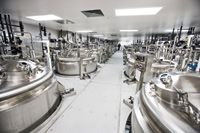
(LONZA, LTD., BASEL, SWITZERLAND)
It may not be necessary to produce antibodies at such large volumes because the same amount of product mass can be obtained from a smaller plant, but from a historical perspective similar arguments have been used for the production of antibiotics and to satisfy the global requirement for Protein A in processes for the purification of MAbs.1–2 Therefore, this article will assume that there is, or will be, the need for high-titer, large-volume fermentations to supply the market for MAbs.
Plant and Model Limitations
Models are useful tools to define process performance and gain insight into process fit in the confines of an existing plant. They are, of course, only an approximation—a model of the real situation limited by the information available for input. Models are as varied as their outputs, and are often constructed to answer a question or range of questions, which explains some of the variability seen in the conclusions reached in the literature.3
The goal of this model was to understand how changing titers affected a largely idealized production plant in its ability to match the purification output with that of the fermenters. This means that the numbers given in terms of fermenter titer represent the maximum that can be processed in the plant before the downstream operation limits the number of batches that can be produced per annum.
If we consider a plant constructed to produce MAbs for in-market supply and apply limitations to its operation, we can start to see where the bottlenecks occur, and begin to identify techniques and technologies to target the causes. In this case, the major limitations of the model are described in Table 1.
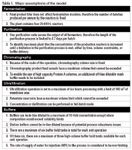
Table 1. Major assumptions of the model
Process Changes
Table 2 summarizes the evolution of the process, taking us from how processes were developed around five years ago, through today's modern processes, and how these might change in the future using some of the techniques that are beginning to be adopted by the industry.
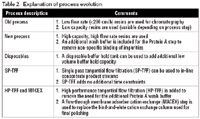
Table 2. Explanation of process evolution
Use of Disposables
For an in-market supply production plant, the use of disposables is more limited than at smaller scales of operation. The financial incentives and physical limitations for using plastic over steel are often high, particularly for chromatography and tangential flow filtration (TFF) operations. There are still areas in the plant where disposables can be used effectively as long as the space and flexibility has been pre-engineered into the facility.
In this instance, the use of disposables is limited to adding buffer hold vessels to the new process. After the processing time bottlenecks have been overcome, the supply of buffer becomes limiting. For this plant, freeing up a large buffer hold vessel by supplementing the hold tanks with 2,000 L of disposable storage enables batches of up to 4.3 g/L to be produced without any bottlenecks (Table 3).

Table 3. Describes where the first bottleneck occurs in each step of the process evolution
Single-Pass TFF
This technique, developed by Pall Life Sciences (East Hills, NY) and based on patented technology, can be thought of as TFF in a direct flow mode.4 One of the main applications of this technology is its use as a fully disposable retention ultrafiltration system for early-phase material manufacture in flexible, low-capital-cost plants. Lonza (Basel, Switzerland) wanted to test the technology for application in large-scale manufacture for the in-line concentration of significant volumes of process streams to allow them to fit in the confines of existing intermediate product hold tanks. The premise of the system is shown in Figure 1—flat sheet membranes are manifolded together to create a serpentine flow path of progressively smaller membrane areas. This maintains the cross-flow across the membranes while the feed stream volume (and hence volumetric flow rate) is reduced.
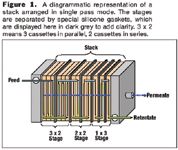
Figure 1. A diagrammatic representation of a stack arranged in single pass mode. The stages are separated by special silicone gaskets, which are displayed here in dark grey to add clarity. 3 x 2 means 3 cassettes in parallel, 2 cassettes in series.
Because the operation is pressure driven, the stack can be arranged as an in-line filter and controlled through the inlet and outlet pressures or flow rate. In this analysis, the operation of such a rig becomes part of the transfer of product from one unit operation to the next and, as such, has no impact on the processing time.
High-Performance TFF
Ultrafiltration processes for the production of MAbs have typically been used to concentrate the product and diafilter it into a buffer suitable for the next processing step. Because of the conventional wisdom that separation ratios of 10:1 (retained solute molecular weight to transmitted solute molecular weight) are necessary, the industry has paid relatively little attention to the abilities of ultrafiltration membranes to purify process streams. Many researchers have shown that by controlling the hydrodynamic operation and build up of the fouling layer and the feed stream conditions, this ratio can be greatly reduced and even reversed.5–7 It has also been demonstrated that charged membranes can achieve two-dimensional separation, although there are currently few such membranes available on the market.8
Commercially available membranes have been used to avoid the complex wash buffers required by high-capacity Protein A resins when combined with a membrane process performed under appropriate conditions using no more automation than is available with an existing ultrafiltration rig. Because these wash buffers are not suitable for in-line dilution, they can become a limitation to plant throughput. Therefore, including an additional unit operation in a process can actually improve plant throughput.
Cation Exchange Membrane Adsorbers
After the limitation of the Protein A wash buffer is removed, time again becomes a limiting factor. The longest processing time at high titers in this example will become the final polishing step to remove aggregates (performed with a high flow rate cation exchange resin). A membrane adsorber was tested to overcome this issue. Membrane adsorbers have previously been used in MAb manufacture for the removal of impurities and viruses, so the precedent exists to use this type of technology in established manufacturing processes.9 Because the binding capacity of adsorbers is less than that of chromatography resins, it was decided to develop the process in flow-through mode. This had the added advantage of reducing buffer volumes.
Capacities were high compared to chromatography, and flow rates increased by more than an order of magnitude, so the processing time of the unit operation was greatly reduced. Step yields and aggregate clearance were comparable, if not better than those seen with the high flow rate resin (Figure 2). The use of this technique combined with HP-TFF enabled the purification of fermentation batches of 9.1 g/L titer with no bottlenecks.
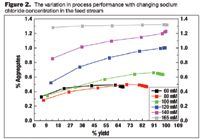
Figure 2. The variation in process performance with changing sodium chloride concentration in the feed stream
Conclusions
Improvements in downstream process design have enabled significant increases in plant throughput to be achieved. Limitations can still exist, but the implementation of existing technologies can improve the capability of the purification process still further. It is therefore possible to purify the output of even the largest scale fermenter to beyond 5 g/L, even approaching 10 g/L (Figure 3), by the implementation of techniques without the need for radical process re-design or expensive retrofitting of existing manufacturing facilities.
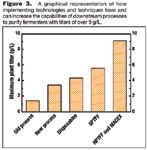
Figure 3. A graphical representation of how implementing technologies and techniques have and can increase the capabilities of downstream processes to purify fermenters with titers of over 9 g/L.
JIM DAVIES is the principal group leader in purification development at Lonza, Berkshire, UK (headquartered in Basel, Switzerland), +44 0 1753 716634, jim.davies@lonza.com
References
1. Buckland, BC, Lilly MD. Fermentation: an overview. In: Stephanopoulos X, editor. Biotechnology, 2nd edition, volume 3. New York: Wiley-VCH; 1993.
2. Jagschies, G. Antibody purification from high titre cell lines. Bioproduction. Dublin; 2006 Oct 24–6.
3. Hagel L, Jagschies G, Sofer G. Handbook of process chromatography: Development, manufacturing, validation, and economics, 2nd edition. London: Elsevier; 2008.
4. De los Reyes G, Mir L, inventors; SPF Innovations, assignee. Method and apparatus for the filtration of biological solutions. United States patent US 7384549. 2008 Jun 10.
5. Van Reis R, Gadam S, Frautschy LN, Orlando S, Goodrich EM, Saksena S, Kuriyel R, Simpson CM, Pearl S. Zydney AL. High performance tangential flow filtration. Biotechnol Bioeng. 1997;56:71–82.
6. Ghosh, R. Protein Bioseparation Using Ultrafiltration; Theory, Applications and New Developments. London: Imperial College Press; 2003.
7. Wan Y, Ghosh R, Hale G, Cui Z. Fractionation of bovine serum albumin and monoclonal antibody Alemtuzumab using carrier phase ultrafiltration. Biotechnol Bioeng. 2005;90:303–15.
8. Christy C, Adams G, Kuriyel R, Bolton G, Seilly A. High-performance tangential flow filtration: a highly selective membrane separation process. Desalination. 2002;144:133–6.
9. Zhou JX, Tressel T. Basic concepts in Q membrane chromatography for large-scale antibody production. Biotechnol Progr. 2006;22:341–349.
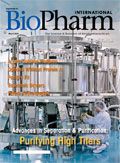
VERAXA and Voyager to Create Combined Business for Advancing Pipeline of Next-Gen Cancer Therapies
April 23rd 2025The proposed business combination would create a publicly traded, clinical-stage biopharmaceutical company that will focus on developing a pipeline of next-generation cancer therapies.
MHRA Approves GSK Therapy Combinations for Multiple Myeloma
April 21st 2025Belantamab mafodotin is approved in combination with bortezomib plus dexamethasone in patients who have had at least one prior therapy, and in combination with pomalidomide plus dexamethasone for those who have had a prior therapy including lenalidomide.
Tokyo University of Science Research Team Explores Improved Delivery of Antisense Oligonucleotides
April 18th 2025Using cholesterol-modified oligonucleotides, the research team aims to improve the delivery of antisense nucleotide-based therapies for treating neurodegenerative diseases and brain cancers.